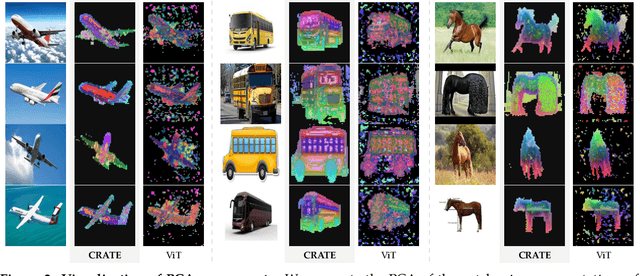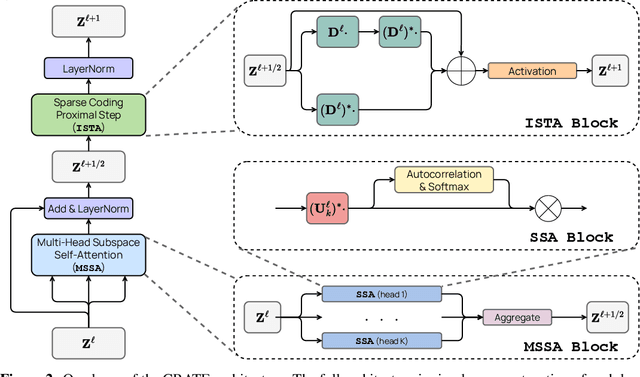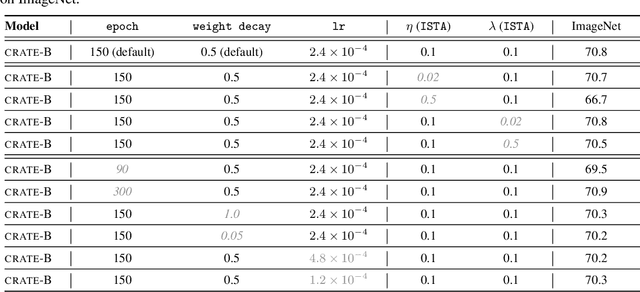Ziyang Wu
Language-Image Alignment with Fixed Text Encoders
Jun 04, 2025Abstract:Currently, the most dominant approach to establishing language-image alignment is to pre-train text and image encoders jointly through contrastive learning, such as CLIP and its variants. In this work, we question whether such a costly joint training is necessary. In particular, we investigate if a pre-trained fixed large language model (LLM) offers a good enough text encoder to guide visual representation learning. That is, we propose to learn Language-Image alignment with a Fixed Text encoder (LIFT) from an LLM by training only the image encoder. Somewhat surprisingly, through comprehensive benchmarking and ablation studies, we find that this much simplified framework LIFT is highly effective and it outperforms CLIP in most scenarios that involve compositional understanding and long captions, while achieving considerable gains in computational efficiency. Our work takes a first step towards systematically exploring how text embeddings from LLMs can guide visual learning and suggests an alternative design choice for learning language-aligned visual representations.
Token Statistics Transformer: Linear-Time Attention via Variational Rate Reduction
Dec 23, 2024



Abstract:The attention operator is arguably the key distinguishing factor of transformer architectures, which have demonstrated state-of-the-art performance on a variety of tasks. However, transformer attention operators often impose a significant computational burden, with the computational complexity scaling quadratically with the number of tokens. In this work, we propose a novel transformer attention operator whose computational complexity scales linearly with the number of tokens. We derive our network architecture by extending prior work which has shown that a transformer style architecture naturally arises by "white-box" architecture design, where each layer of the network is designed to implement an incremental optimization step of a maximal coding rate reduction objective (MCR$^2$). Specifically, we derive a novel variational form of the MCR$^2$ objective and show that the architecture that results from unrolled gradient descent of this variational objective leads to a new attention module called Token Statistics Self-Attention (TSSA). TSSA has linear computational and memory complexity and radically departs from the typical attention architecture that computes pairwise similarities between tokens. Experiments on vision, language, and long sequence tasks show that simply swapping TSSA for standard self-attention, which we refer to as the Token Statistics Transformer (ToST), achieves competitive performance with conventional transformers while being significantly more computationally efficient and interpretable. Our results also somewhat call into question the conventional wisdom that pairwise similarity style attention mechanisms are critical to the success of transformer architectures. Code will be available at https://github.com/RobinWu218/ToST.
Spatial-Temporal Mixture-of-Graph-Experts for Multi-Type Crime Prediction
Sep 24, 2024



Abstract:As various types of crime continue to threaten public safety and economic development, predicting the occurrence of multiple types of crimes becomes increasingly vital for effective prevention measures. Although extensive efforts have been made, most of them overlook the heterogeneity of different crime categories and fail to address the issue of imbalanced spatial distribution. In this work, we propose a Spatial-Temporal Mixture-of-Graph-Experts (ST-MoGE) framework for collective multiple-type crime prediction. To enhance the model's ability to identify diverse spatial-temporal dependencies and mitigate potential conflicts caused by spatial-temporal heterogeneity of different crime categories, we introduce an attentive-gated Mixture-of-Graph-Experts (MGEs) module to capture the distinctive and shared crime patterns of each crime category. Then, we propose Cross-Expert Contrastive Learning(CECL) to update the MGEs and force each expert to focus on specific pattern modeling, thereby reducing blending and redundancy. Furthermore, to address the issue of imbalanced spatial distribution, we propose a Hierarchical Adaptive Loss Re-weighting (HALR) approach to eliminate biases and insufficient learning of data-scarce regions. To evaluate the effectiveness of our methods, we conduct comprehensive experiments on two real-world crime datasets and compare our results with twelve advanced baselines. The experimental results demonstrate the superiority of our methods.
A Survey of Foundation Models for Music Understanding
Sep 15, 2024Abstract:Music is essential in daily life, fulfilling emotional and entertainment needs, and connecting us personally, socially, and culturally. A better understanding of music can enhance our emotions, cognitive skills, and cultural connections. The rapid advancement of artificial intelligence (AI) has introduced new ways to analyze music, aiming to replicate human understanding of music and provide related services. While the traditional models focused on audio features and simple tasks, the recent development of large language models (LLMs) and foundation models (FMs), which excel in various fields by integrating semantic information and demonstrating strong reasoning abilities, could capture complex musical features and patterns, integrate music with language and incorporate rich musical, emotional and psychological knowledge. Therefore, they have the potential in handling complex music understanding tasks from a semantic perspective, producing outputs closer to human perception. This work, to our best knowledge, is one of the early reviews of the intersection of AI techniques and music understanding. We investigated, analyzed, and tested recent large-scale music foundation models in respect of their music comprehension abilities. We also discussed their limitations and proposed possible future directions, offering insights for researchers in this field.
LLoCO: Learning Long Contexts Offline
Apr 11, 2024Abstract:Processing long contexts remains a challenge for large language models (LLMs) due to the quadratic computational and memory overhead of the self-attention mechanism and the substantial KV cache sizes during generation. We propose a novel approach to address this problem by learning contexts offline through context compression and in-domain parameter-efficient finetuning. Our method enables an LLM to create a concise representation of the original context and efficiently retrieve relevant information to answer questions accurately. We introduce LLoCO, a technique that combines context compression, retrieval, and parameter-efficient finetuning using LoRA. Our approach extends the effective context window of a 4k token LLaMA2-7B model to handle up to 128k tokens. We evaluate our approach on several long-context question-answering datasets, demonstrating that LLoCO significantly outperforms in-context learning while using $30\times$ fewer tokens during inference. LLoCO achieves up to $7.62\times$ speed-up and substantially reduces the cost of long document question answering, making it a promising solution for efficient long context processing. Our code is publicly available at https://github.com/jeffreysijuntan/lloco.
Masked Completion via Structured Diffusion with White-Box Transformers
Apr 03, 2024Abstract:Modern learning frameworks often train deep neural networks with massive amounts of unlabeled data to learn representations by solving simple pretext tasks, then use the representations as foundations for downstream tasks. These networks are empirically designed; as such, they are usually not interpretable, their representations are not structured, and their designs are potentially redundant. White-box deep networks, in which each layer explicitly identifies and transforms structures in the data, present a promising alternative. However, existing white-box architectures have only been shown to work at scale in supervised settings with labeled data, such as classification. In this work, we provide the first instantiation of the white-box design paradigm that can be applied to large-scale unsupervised representation learning. We do this by exploiting a fundamental connection between diffusion, compression, and (masked) completion, deriving a deep transformer-like masked autoencoder architecture, called CRATE-MAE, in which the role of each layer is mathematically fully interpretable: they transform the data distribution to and from a structured representation. Extensive empirical evaluations confirm our analytical insights. CRATE-MAE demonstrates highly promising performance on large-scale imagery datasets while using only ~30% of the parameters compared to the standard masked autoencoder with the same model configuration. The representations learned by CRATE-MAE have explicit structure and also contain semantic meaning. Code is available at https://github.com/Ma-Lab-Berkeley/CRATE .
When Do We Not Need Larger Vision Models?
Mar 19, 2024Abstract:Scaling up the size of vision models has been the de facto standard to obtain more powerful visual representations. In this work, we discuss the point beyond which larger vision models are not necessary. First, we demonstrate the power of Scaling on Scales (S$^2$), whereby a pre-trained and frozen smaller vision model (e.g., ViT-B or ViT-L), run over multiple image scales, can outperform larger models (e.g., ViT-H or ViT-G) on classification, segmentation, depth estimation, Multimodal LLM (MLLM) benchmarks, and robotic manipulation. Notably, S$^2$ achieves state-of-the-art performance in detailed understanding of MLLM on the V* benchmark, surpassing models such as GPT-4V. We examine the conditions under which S$^2$ is a preferred scaling approach compared to scaling on model size. While larger models have the advantage of better generalization on hard examples, we show that features of larger vision models can be well approximated by those of multi-scale smaller models. This suggests most, if not all, of the representations learned by current large pre-trained models can also be obtained from multi-scale smaller models. Our results show that a multi-scale smaller model has comparable learning capacity to a larger model, and pre-training smaller models with S$^2$ can match or even exceed the advantage of larger models. We release a Python package that can apply S$^2$ on any vision model with one line of code: https://github.com/bfshi/scaling_on_scales.
White-Box Transformers via Sparse Rate Reduction: Compression Is All There Is?
Nov 24, 2023



Abstract:In this paper, we contend that a natural objective of representation learning is to compress and transform the distribution of the data, say sets of tokens, towards a low-dimensional Gaussian mixture supported on incoherent subspaces. The goodness of such a representation can be evaluated by a principled measure, called sparse rate reduction, that simultaneously maximizes the intrinsic information gain and extrinsic sparsity of the learned representation. From this perspective, popular deep network architectures, including transformers, can be viewed as realizing iterative schemes to optimize this measure. Particularly, we derive a transformer block from alternating optimization on parts of this objective: the multi-head self-attention operator compresses the representation by implementing an approximate gradient descent step on the coding rate of the features, and the subsequent multi-layer perceptron sparsifies the features. This leads to a family of white-box transformer-like deep network architectures, named CRATE, which are mathematically fully interpretable. We show, by way of a novel connection between denoising and compression, that the inverse to the aforementioned compressive encoding can be realized by the same class of CRATE architectures. Thus, the so-derived white-box architectures are universal to both encoders and decoders. Experiments show that these networks, despite their simplicity, indeed learn to compress and sparsify representations of large-scale real-world image and text datasets, and achieve performance very close to highly engineered transformer-based models: ViT, MAE, DINO, BERT, and GPT2. We believe the proposed computational framework demonstrates great potential in bridging the gap between theory and practice of deep learning, from a unified perspective of data compression. Code is available at: https://ma-lab-berkeley.github.io/CRATE .
Emergence of Segmentation with Minimalistic White-Box Transformers
Aug 30, 2023



Abstract:Transformer-like models for vision tasks have recently proven effective for a wide range of downstream applications such as segmentation and detection. Previous works have shown that segmentation properties emerge in vision transformers (ViTs) trained using self-supervised methods such as DINO, but not in those trained on supervised classification tasks. In this study, we probe whether segmentation emerges in transformer-based models solely as a result of intricate self-supervised learning mechanisms, or if the same emergence can be achieved under much broader conditions through proper design of the model architecture. Through extensive experimental results, we demonstrate that when employing a white-box transformer-like architecture known as CRATE, whose design explicitly models and pursues low-dimensional structures in the data distribution, segmentation properties, at both the whole and parts levels, already emerge with a minimalistic supervised training recipe. Layer-wise finer-grained analysis reveals that the emergent properties strongly corroborate the designed mathematical functions of the white-box network. Our results suggest a path to design white-box foundation models that are simultaneously highly performant and mathematically fully interpretable. Code is at \url{https://github.com/Ma-Lab-Berkeley/CRATE}.
White-Box Transformers via Sparse Rate Reduction
Jun 01, 2023



Abstract:In this paper, we contend that the objective of representation learning is to compress and transform the distribution of the data, say sets of tokens, towards a mixture of low-dimensional Gaussian distributions supported on incoherent subspaces. The quality of the final representation can be measured by a unified objective function called sparse rate reduction. From this perspective, popular deep networks such as transformers can be naturally viewed as realizing iterative schemes to optimize this objective incrementally. Particularly, we show that the standard transformer block can be derived from alternating optimization on complementary parts of this objective: the multi-head self-attention operator can be viewed as a gradient descent step to compress the token sets by minimizing their lossy coding rate, and the subsequent multi-layer perceptron can be viewed as attempting to sparsify the representation of the tokens. This leads to a family of white-box transformer-like deep network architectures which are mathematically fully interpretable. Despite their simplicity, experiments show that these networks indeed learn to optimize the designed objective: they compress and sparsify representations of large-scale real-world vision datasets such as ImageNet, and achieve performance very close to thoroughly engineered transformers such as ViT. Code is at \url{https://github.com/Ma-Lab-Berkeley/CRATE}.
 Add to Chrome
Add to Chrome Add to Firefox
Add to Firefox Add to Edge
Add to Edge